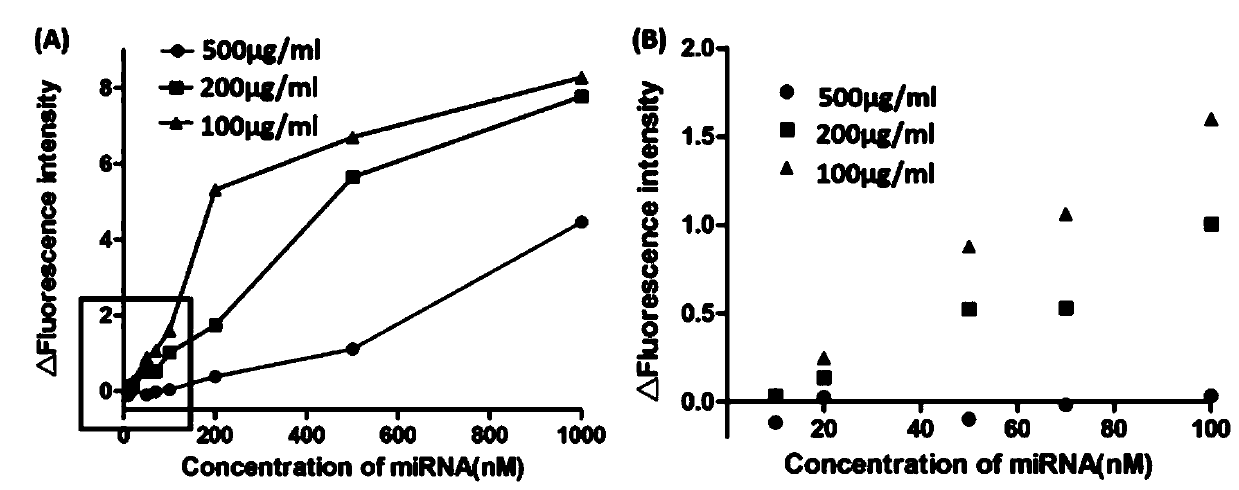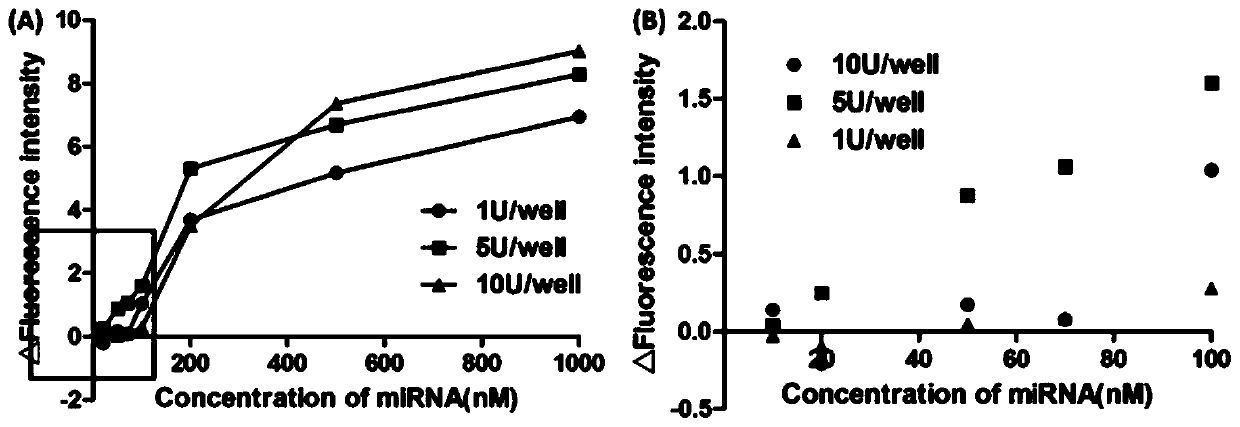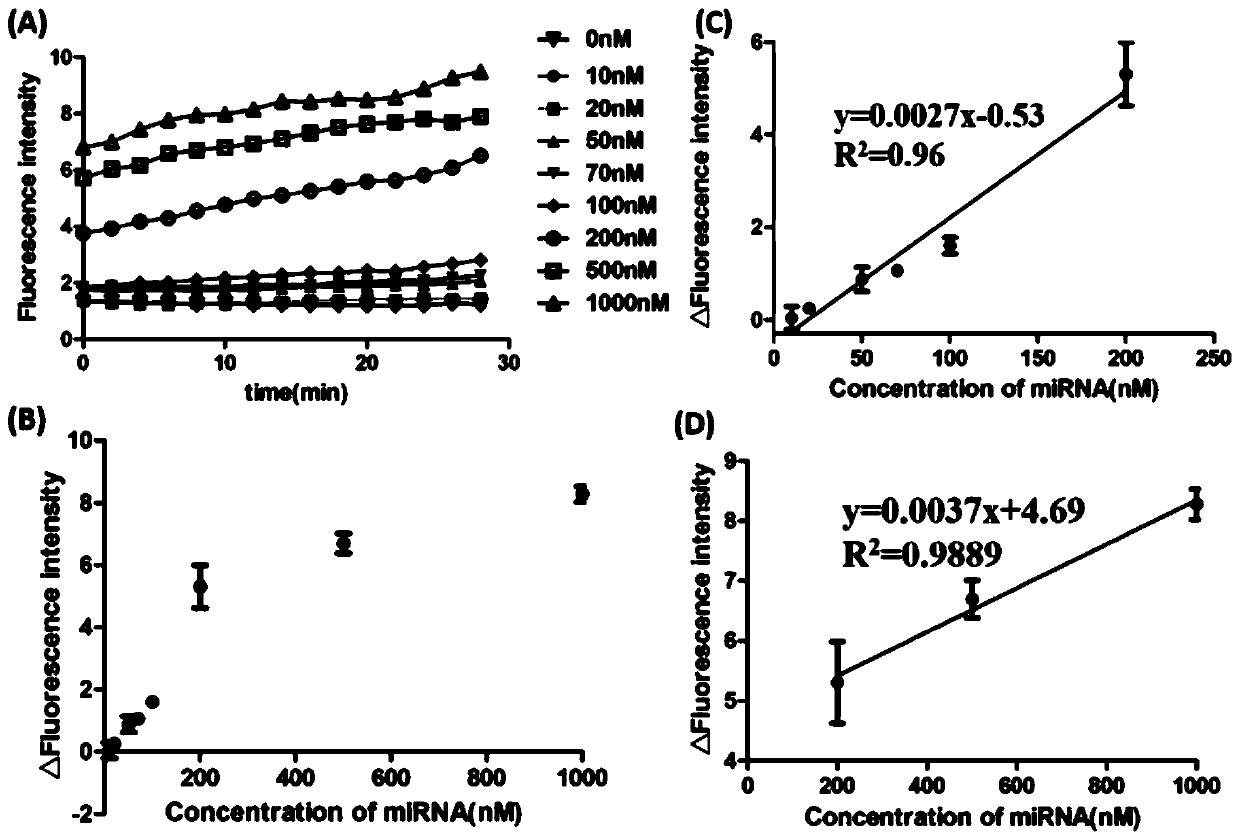Signal-amplification fluorescence detection system, fluorescence biosensor and application thereof
A fluorescence detection and signal amplification technology, applied in fluorescence/phosphorescence, instruments, measuring devices, etc., can solve the problems of limited quantitative accuracy, cumbersome detection steps, and high detection cost, and achieve improved accuracy, high signal-to-noise ratio, and high The effect of detection sensitivity
- Summary
- Abstract
- Description
- Claims
- Application Information
AI Technical Summary
Problems solved by technology
Method used
Image
Examples
Embodiment 1
[0044] This embodiment provides a fluorescence detection system, including the following components:
[0045] 1. The recognition unit is a single-stranded DNA probe labeled with a fluorescent molecule. Specifically, the recognition unit includes: a streptavidin-labeled fluorescent molecule, a biotin-labeled single-stranded DNA molecule (ssDNA), and streptomycin is coupled with biotin to form a recognition unit. Wherein, the fluorescent molecules are specifically fluorescent quantum dots (CdSe / ZnS quantum dots), and the coupling molar ratio of streptavidin-labeled fluorescent molecules to biotin-labeled single-stranded DNA molecules is 1:4. The nucleotide sequence of the single-stranded DNA molecule is selected from any nucleotide sequence shown in SEQ ID NO.1-SEQ ID NO.3, specifically selects the nucleotide sequence of SEQ ID NO.1 in this embodiment, has The recognition unit of the nucleotide sequence of SEQ ID NO.1 can recognize and bind to the biomarker molecule miRNA1 of A...
Embodiment 2
[0052] This embodiment provides a fluorescent biosensor, including the fluorescence detection system in Embodiment 1. Fluorescent biosensors can realize the rapid detection of biomarker molecules of Alzheimer's disease, and have the advantages of fast, simple, sensitive, efficient and accurate, and can be used for disease screening of Alzheimer's disease with diagnosis.
experiment example 1
[0054] 1. Experimental purpose: To optimize the conditions of the fluorescence detection system in Example 1 to improve the detection performance.
[0055] 2. Experimental process and results:
[0056] Fluorescence detection was performed using a multifunctional microplate reader Variokan Flash (Thermo Scientific, USA) in a black 96-well plate. 100 μL of different concentrations of miRNA (1000 nM, 500 nM, 200 nM, 100 nM, 50 nM, 20 nM, 10 nM and OnM) were added to the fluorescence detection system and incubated for 10 minutes. Then add DnaseI to each well and incubate for 30 minutes. During the detection process, the fluorescence emission intensity at 520 nm (excitation wavelength: 380 nm) was recorded every five minutes. Change the addition amount of graphene oxide (GO) and DNase I in the fluorescence detection system, compare three concentrations of GO (500μg / ml, 200μg / ml, 100μg / ml) and five kinds of DNase I additions (10U, The fluorescence detection results under the cond...
PUM
 Login to View More
Login to View More Abstract
Description
Claims
Application Information
 Login to View More
Login to View More - R&D
- Intellectual Property
- Life Sciences
- Materials
- Tech Scout
- Unparalleled Data Quality
- Higher Quality Content
- 60% Fewer Hallucinations
Browse by: Latest US Patents, China's latest patents, Technical Efficacy Thesaurus, Application Domain, Technology Topic, Popular Technical Reports.
© 2025 PatSnap. All rights reserved.Legal|Privacy policy|Modern Slavery Act Transparency Statement|Sitemap|About US| Contact US: help@patsnap.com



